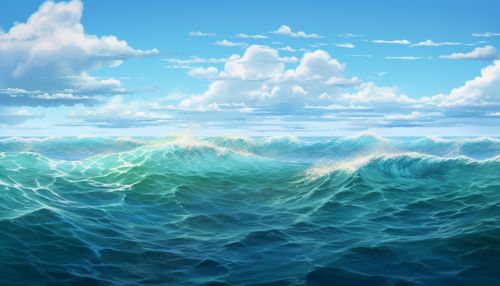Ocean current
Introduction
Ocean currents are continuous, directed movements of seawater generated by various forces acting upon the water, including wind, the Coriolis effect, breaking waves, cabbeling, temperature and salinity differences. They are primarily horizontal water movements. An oceanographer studies ocean currents and their impact on climate, navigation, and marine life.
Classification of Ocean Currents
Ocean currents can be classified into two broad types: surface currents and deep water currents.
Surface Currents
Surface currents, which make up about 10% of all the water in the ocean, are generally caused by wind. They occur at or near the ocean's surface and typically move in circular patterns. These currents can be large, spanning hundreds to thousands of kilometers, and they can be persistent, lasting for several years.
Deep Water Currents
Deep water currents, also known as thermohaline circulation, make up the other 90% of ocean water. These currents are driven by differences in the water's density, which is controlled by temperature (thermo) and salinity (haline). This process is known as thermohaline circulation.
Factors Influencing Ocean Currents
Several factors influence the direction and speed of ocean currents, including the wind, the rotation of the Earth, and the shape of the ocean basins.
Wind
Wind drives surface currents. The friction between the wind and the water's surface pushes the water along in the direction of the wind. This is a direct influence of wind on the surface currents.
Coriolis Effect
The Coriolis effect is an apparent force caused by the Earth's rotation. This effect causes moving fluids, like air and water, to turn to the right in the northern hemisphere and to the left in the southern hemisphere. This effect greatly influences the direction of ocean currents.
Ocean Basin Topography
The shape and features of the ocean basins also influence the direction of ocean currents. The presence of continental masses interrupts the free circulation of water around the globe, and the ocean floor topography can influence the direction and speed of deep water currents.
Impact of Ocean Currents
Ocean currents have a profound impact on our planet's climate, marine life, and human activities.
Climate Regulation
Ocean currents play a crucial role in regulating the Earth's climate. They redistribute heat from the equator to the poles, moderating the climate and making it habitable.
Marine Life
Ocean currents also have a significant impact on marine life. They transport nutrients from the deep sea to the surface, supporting the growth of phytoplankton, the base of the marine food web.
Historically, ocean currents have been essential for navigation. Mariners have used them to travel across the seas more efficiently. Even today, understanding ocean currents is crucial for shipping routes.
Future Research
The study of ocean currents is a vital area of research in oceanography. Scientists are using advanced technology, like satellite data and autonomous underwater vehicles, to better understand these currents and their impacts on our planet.
See Also


